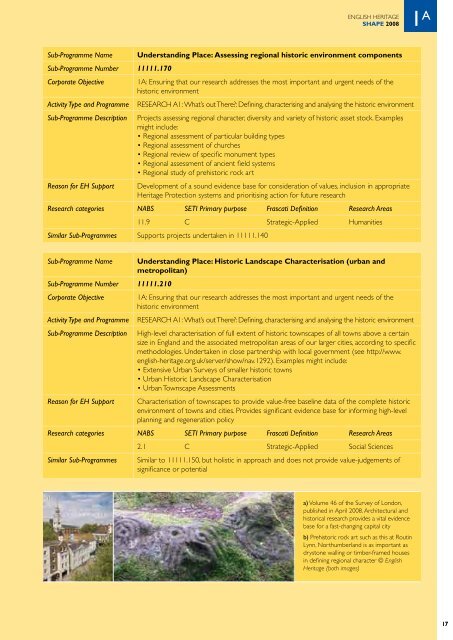shape | pdf - English Heritage
shape | pdf - English Heritage
shape | pdf - English Heritage
You also want an ePaper? Increase the reach of your titles
YUMPU automatically turns print PDFs into web optimized ePapers that Google loves.
english heritage<br />
<strong>shape</strong> 2008<br />
1 A<br />
Sub-Programme Name<br />
Sub-Programme Number 11111.170<br />
Corporate Objective<br />
Activity Type and Programme<br />
Sub-Programme Description<br />
Reason for EH Support<br />
Understanding Place: Assessing regional historic environment components<br />
1A: Ensuring that our research addresses the most important and urgent needs of the<br />
historic environment<br />
RESEARCH A1: What’s out There?: Defining, characterising and analysing the historic environment<br />
Projects assessing regional character, diversity and variety of historic asset stock. Examples<br />
might include:<br />
• Regional assessment of particular building types<br />
• Regional assessment of churches<br />
• Regional review of specific monument types<br />
• Regional assessment of ancient field systems<br />
• Regional study of prehistoric rock art<br />
Development of a sound evidence base for consideration of values, inclusion in appropriate<br />
<strong>Heritage</strong> Protection systems and prioritising action for future research<br />
Research categories NABS SETI Primary purpose Frascati Definition Research Areas<br />
11.9 C Strategic-Applied Humanities<br />
Similar Sub-Programmes Supports projects undertaken in 11111.140<br />
Sub-Programme Name<br />
Sub-Programme Number 11111.210<br />
Corporate Objective<br />
Activity Type and Programme<br />
Sub-Programme Description<br />
Reason for EH Support<br />
Understanding Place: Historic Landscape Characterisation (urban and<br />
metropolitan)<br />
1A: Ensuring that our research addresses the most important and urgent needs of the<br />
historic environment<br />
RESEARCH A1: What’s out There?: Defining, characterising and analysing the historic environment<br />
High-level characterisation of full extent of historic townscapes of all towns above a certain<br />
size in England and the associated metropolitan areas of our larger cities, according to specific<br />
methodologies. Undertaken in close partnership with local government (see http://www.<br />
english-heritage.org.uk/server/show/nav.1292). Examples might include:<br />
• Extensive Urban Surveys of smaller historic towns<br />
• Urban Historic Landscape Characterisation<br />
• Urban Townscape Assessments<br />
Characterisation of townscapes to provide value-free baseline data of the complete historic<br />
environment of towns and cities. Provides significant evidence base for informing high-level<br />
planning and regeneration policy<br />
Research categories NABS SETI Primary purpose Frascati Definition Research Areas<br />
Similar Sub-Programmes<br />
2.1 C Strategic-Applied Social Sciences<br />
Similar to 11111.150, but holistic in approach and does not provide value-judgements of<br />
significance or potential<br />
a)<br />
b)<br />
© Tim Cromack,, <strong>English</strong> <strong>Heritage</strong><br />
a) Volume 46 of the Survey of London,<br />
published in April 2008. Architectural and<br />
historical research provides a vital evidence<br />
base for a fast-changing capital city<br />
b) Prehistoric rock art such as this at Routin<br />
Lynn, Northumberland is as important as<br />
drystone walling or timber-framed houses<br />
in defining regional character © <strong>English</strong><br />
<strong>Heritage</strong> (both images)<br />
17

















